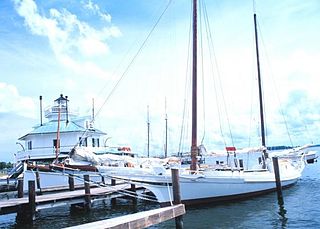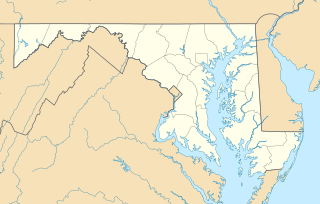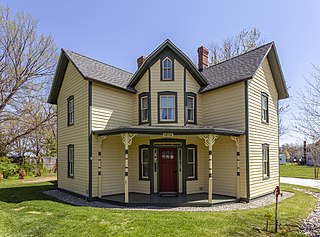
The log canoe is a type of sailboat developed in the Chesapeake Bay region. Based on the dugout, it was the principal traditional fishing boat of the bay until superseded by the bugeye and the skipjack. However, it is most famous as a racing sailboat, and races continue to be held.

The bugeye is a type of sailboat developed in the Chesapeake Bay for oyster dredging. The predecessor of the skipjack, it was superseded by the latter as oyster harvests dropped.

The Edna E. Lockwood is a Chesapeake Bay bugeye, the last working oyster boat of her kind. She is located at the Chesapeake Bay Maritime Museum in Saint Michaels, Maryland. She was built in 1889 at Tilghman Island, Maryland by John B. Harrison and is of nine-log construction, similar to the smaller log canoe, and was launched on October 5, 1889 for Daniel Haddaway, at a cost of $2,200. She worked for at least seven sets of owners from 1899 until 1967, and was then sailed as a yacht until donated to the museum in 1973. The museum undertook an extensive restoration of the Lockwood from 1975 through 1979, which restored the bugeye to its 1910 appearance with the "patent stern" that had been added sometime prior to that year. She is the last bugeye retaining the sailing rig and working appearance of the type. Her length is 53.5 feet (16.3 m), with a 15.25 feet (4.65 m) beam and a draft of 2.58 feet (0.79 m) with the centerboard up, and a maximum sail area of approximately 1700 square feet.

The Edmee S. is a Chesapeake Bay log canoe. She was built in the Tilghman Island style from hewn logs by Oliver Duke in the 1930s. She is one of the last 22 Chesapeake Bay racing log canoes, and is actively raced with a crew of nine to eleven people. Her original name was Cecilia Mae, but was renamed for Edmee S. Combs, whose husband funded the restoration. The hull was covered with fiberglass during the restoration. She is owned by the Chesapeake Bay Maritime Museum in Saint Michaels, Maryland.

The Island Image is a Chesapeake Bay log canoe, built in 1885 at Elliot's Island, Maryland, by Herman Jones and Isaac Moore. She is 29'-8½" long with a beam of 5-10¼", and has a straight, raking stem and a sharp stern. It is privately owned, and races under No. 17. She one of the last 22 surviving traditional Chesapeake Bay racing log canoes that carry on a tradition of racing on the Eastern Shore of Maryland that has existed since the 1840s. She is located at Chestertown, Kent County, Maryland.

The Silver Heel is a Chesapeake Bay log canoe, built in 1902, in Kent County, Maryland by Eugene Thompson for John Wesley Dickinson. She is a 33'-113⁄4" sailing log canoe in the racing fleet. She has a beam of 7'-3/4". She has a clipper bow, with the longhead braced to serve as a bowsprit, and a straight, raking stern. The canoe is privately owned and races under No. 2. She one of the last 22 surviving traditional Chesapeake Bay racing log canoes that carry on a tradition of racing on the Eastern Shore of Maryland that has existed since the 1840s. She is located at Chestertown, Kent County, Maryland.

Billie P. Hall is a Chesapeake Bay log canoe, built in 1903, by Charles Tarr. She is one of the last 22 surviving traditional Chesapeake Bay racing log canoes to carry on a tradition of racing on the Eastern Shore of Maryland that has existed since the 1840s. She is located at Oxford, Talbot County, Maryland.

The Island Bird is a Chesapeake Bay log canoe, built in 1882, by William Sidney Covington in Tilghman, Maryland. She is a 27 ft 4 in (8.33 m) sailing log canoe with a racing rig, a sharp stem with a longhead bow, and a sharp, raking stern. She is one of the smallest boats in the active racing fleet, with a beam of only 5 ft 6.5 in (1.689 m). The boat is privately owned by the descendants of Mr. Covington and has been racing every season since 1949. She one of the last 22 surviving traditional Chesapeake Bay racing log canoes that carry on a tradition of racing on the Eastern Shore of Maryland that has existed since the 1840s. She is located at St. Michaels, Talbot County, Maryland.

The Island Blossom is a Chesapeake Bay log canoe, built in 1892, by William Sidney Covington in Tilghman, Maryland. She is a 32 ft 7.5 in (9.944 m) sailing log canoe with a beam of 6 feet 7.5 inches (2.019 m). Double-ended, her bow is sharp with a straight, slightly raking stem and a longhead, and she has a sharp stern. The canoe is privately owned by the family John C. North II, descendants of Mr. Covington, and races under No. 9. She is one of the last 22 surviving traditional Chesapeake Bay log canoes, carrying on a tradition of racing on the Eastern Shore of Maryland that has existed since the 1840s. Skippered since 1999 by Corbin Penwell of St. Michaels, Maryland, Island Blossom has won a record 10 consecutive High Point trophies for the fleet's overall season winner, finishing first overall from 2009-2018 to top the previous mark of six in a row originally set by Doug Hanks Sr., also aboard Blossom, between 1981-1986 and matched by Tyler Johnson on Persistence from 1998–2003. She is located at St. Michaels, Talbot County, Maryland.

The Island Lark is a Chesapeake Bay log canoe, built in 1901 and restored by John Chamberlin in 1971. She is a 34'-11" sailing log canoe with a racing rig. She has a beam of 6'-9 1/8". She is double-ended with a sharp, raking stem, longhead bow, and sharp stern. Privately owned the canoe is raced on the Eastern Shore under No. 16. She is one of the last 22 surviving traditional Chesapeake Bay racing log canoes that carry on a tradition of racing on the Eastern Shore of Maryland that has existed since the 1840s. She is located at St. Michaels, Talbot County, Maryland.

The Jay Dee is a Chesapeake Bay log canoe, built in 1931, by John B. Harrison in Tilghman, Maryland, She is 35 feet 6 inches (10.82 m) long with a beam of 8 feet 6 inches (2.59 m), and built of five logs. She is one of the last 22 surviving traditional Chesapeake Bay racing log canoes that carry on a tradition of racing on the Eastern Shore of Maryland which has existed since the 1840s. She is located at St. Michaels, Talbot County, Maryland.

The Magic is a Chesapeake Bay log canoe, built in 1894, by Charles Tarr in St. Michaels, Maryland, She measures 34'-3 5/8" long with a beam of 6'-11". She served as a commercial oystering vessel until 1924 when she was returned to her sailing rig. After her conversion Magic proved to be one of the fastest canoes on the Bay, winning the first Governor's Cup race in 1927. She one of the last 22 surviving traditional Chesapeake Bay racing log canoes that carry on a tradition of racing on the Eastern Shore of Maryland that has existed since the 1840s. She is located at St. Michaels, Talbot County, Maryland.

The Noddy is a Chesapeake Bay log canoe, built in 1930, by Oliver Duke in Royal Oak, Maryland, She measures 27'-6" long, with a beam of 6'-41⁄2". Her log hull remains unglassed, is painted white, and she races under No. 1. She one of the last 22 surviving traditional Chesapeake Bay racing log canoes that carry on a tradition of racing on the Eastern Shore of Maryland that has existed since the 1840s. In 1985 she was located at St. Michaels, Talbot County, Maryland.

The Persistence is a Chesapeake Bay log canoe, built in the 1890s, possibly by John B. Harrison in Tilghman, Maryland. She measures 32'-41⁄2" long, with a beam of 6'-111⁄2" and is double-ended with no longhead on her bow. She is one of the last 22 surviving traditional Chesapeake Bay racing log canoes that carry on a tradition of racing on the Eastern Shore of Maryland that has existed since the 1840s. She is located at St. Michaels, Talbot County, Maryland.

The Rover is a Chesapeake Bay log canoe, built about 1886, probably in Chester, Maryland by the Thompson brothers. She measures 28'-13⁄4" with a 6'-41⁄4" beam. She has a longhead bow, braced back to the hull, and a sharp stern. She is privately owned and races under No. 11 in Eastern Shore competition. She one of the last 22 surviving traditional Chesapeake Bay racing log canoes that carry on a tradition of racing on the Eastern Shore of Maryland that has existed since the 1840s. She is located at St. Michaels, Talbot County, Maryland.

The Sandy is a Chesapeake Bay log canoe. She is a 28'-11⁄4" long sailing log canoe with two masts and a racing rig. Log-built, with carvel-fitted rising planks, the boat has a beam of 6'-81⁄4". She is one of the last 22 surviving traditional Chesapeake Bay racing log canoes, carrying on a tradition of racing on the Eastern Shore of Maryland that has existed since the 1840s. She is located at Sherwood, Talbot County, Maryland.

The Mystery is a Chesapeake Bay log canoe, built in 1932, by Harry Sinclair in Oxford, Maryland. She measures 34'-7" long, has a beam of 8'-81⁄2" and has a centerboard. She is noted for her very tall masts, is privately owned, and races under No. 8. She is one of the last 22 surviving traditional Chesapeake Bay racing log canoes that carry on a tradition of racing on the Eastern Shore of Maryland that has existed since the 1840s. She is located at Kingstown, Queen Anne's County, Maryland.

The Patricia is a Chesapeake Bay log canoe built in 1942 by Oliver Duke. She measures 27'-4" long, and has a beam of 6'-43⁄4". The Patricia has a slightly hollow longhead bow and a sharp stern. Painted white, the canoe races under the no. 19. She is one of twenty-two traditional Chesapeake Bay racing log canoes existing today. The Patricia, and boats like her, carry on a tradition of racing on the Eastern Shore of Maryland that has existed since the 1840s. She is located at Cambridge, Dorchester County, Maryland.

The S. C. Dobson is a Chesapeake Bay log canoe, built about 1895, by James Lowery at Tilghman, Maryland. She measures 33'-13⁄4" and has a beam of 6'-61⁄2". She has a longhead bow, a sharp stern, and a narrow, straight-sided hull. With a Tilghman racing rig she races under No. 6. She one of the last 22 surviving traditional Chesapeake Bay racing log canoes that carry on a tradition of racing on the Eastern Shore of Maryland that has existed since the 1840s.

The Tilghman Watermen's Museum records the maritime traditions of the people of Tilghman Island and the unique way of life of the watermen who lived on the island. It is located on Tilghman Island, Talbot County, Maryland, United States.







